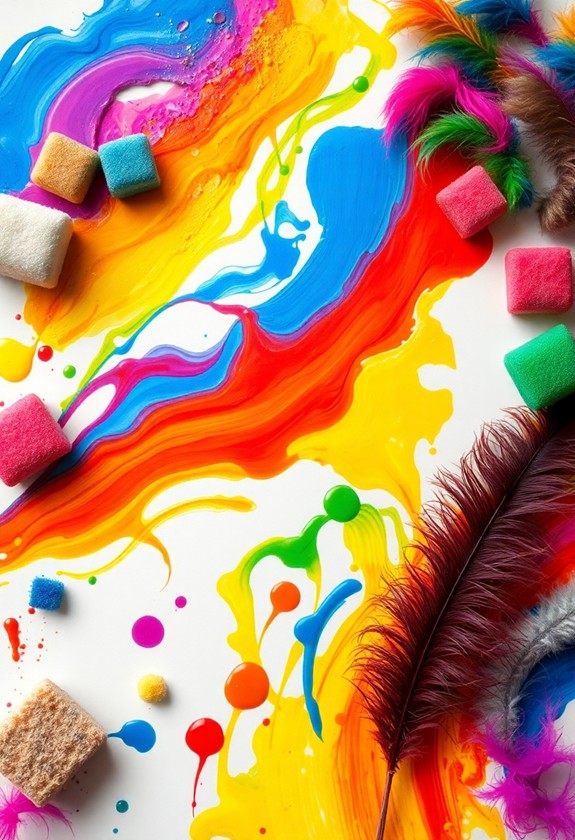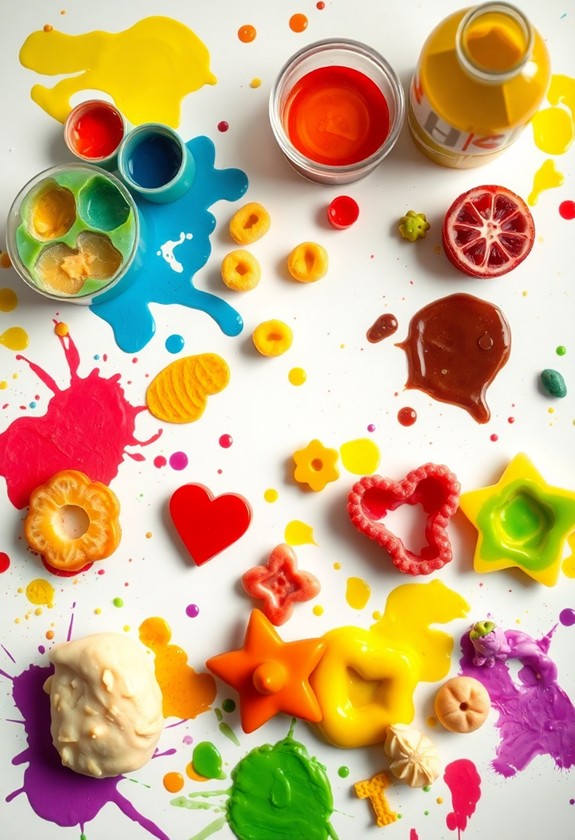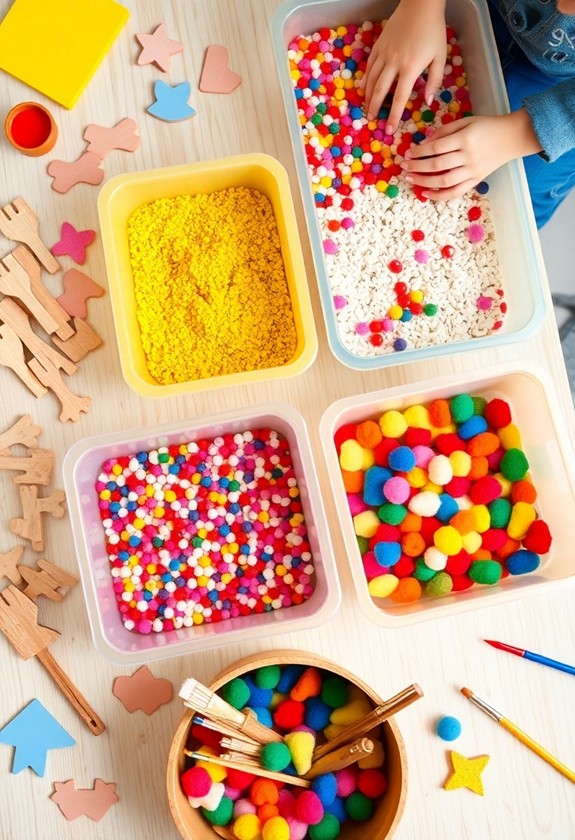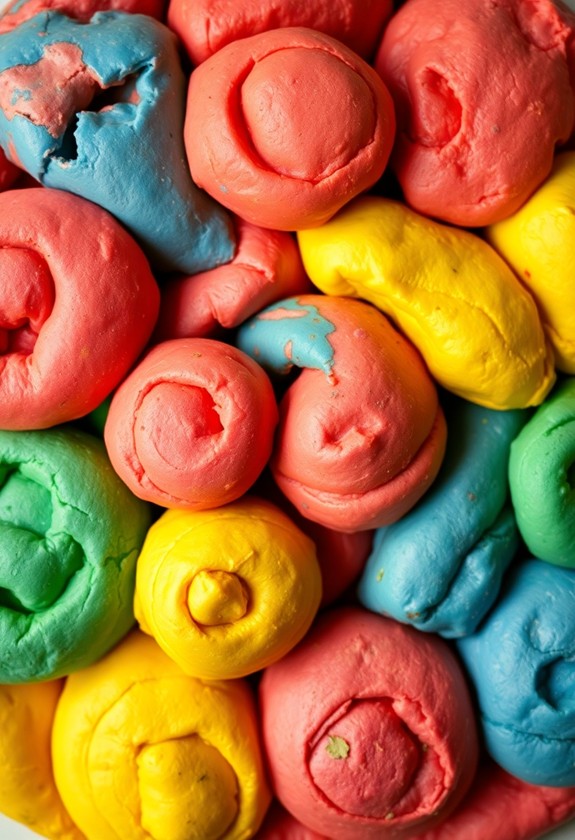Release your toddler's creativity with these 7 sensory art projects! Squish paint in ziplock bags, create textured collages with feathers and sandpaper, or knead scented play dough for aromatic fun. Let them finger paint with edible ingredients, investigate a colorful rice bin, or squish rainbow spaghetti for messy giggles. Don't forget bubble wrap printing for popping good times! These activities engage multiple senses, develop fine motor skills, and spark imagination. Your little one will love squishing, squeezing, and creating as they investigate textures, colors, and smells. Get ready for a whirlwind of artistic adventures that'll have your curious tot begging for more hands-on fun!
Creative Highlights
- Squishy paint bags allow toddlers to create swirling patterns and mix colors without mess, developing fine motor skills.
- Textured collages using various materials encourage sensory exploration and enhance vocabulary through tactile experiences.
- Scented play dough creation engages multiple senses, promoting creativity and hands-on learning through kneading and shaping.
- Edible finger painting combines art and snack time, enabling safe exploration of colors and textures.
- Sensory rice bins with colorful objects foster investigation skills and improve hand-eye coordination through scooping and pouring activities.
Squishy Paint Bag Exploration
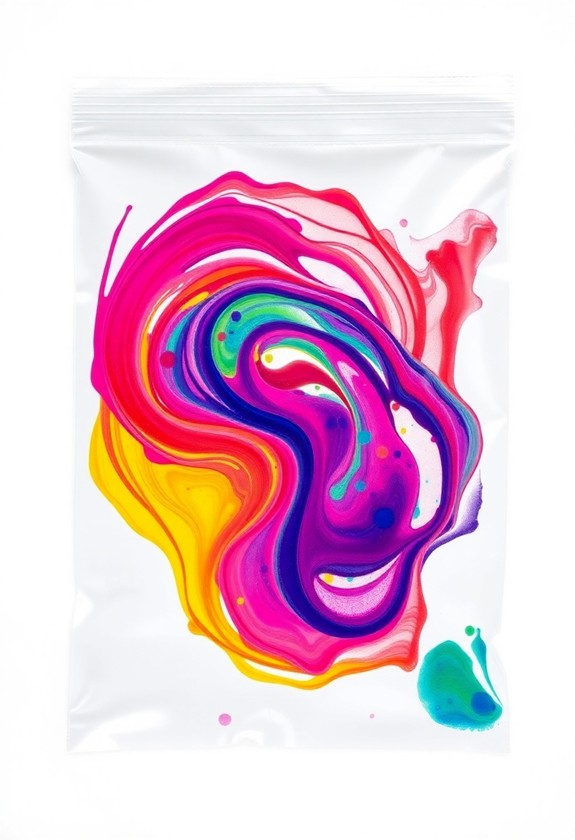
Plunge into a mess-free sensory experience with squishy paint bags. It's a colorful adventure for little hands! Here's what you'll need:
- Ziploc bags
- Washable paint
- Tape
- White paper (optional)
Fill each bag with a dollop of paint, seal it tight, and secure with tape. Now, let your toddler squish, squeeze, and smoosh to their heart's content! Watch as they create swirling patterns and mix colors like mini-artists. This activity aligns with the worry-free creativity principle, allowing toddlers to express themselves without stress over potential mess. It's likewise an excellent way to develop fine motor skills in a controlled environment.
For extra fun, tape the bags to a window or table. Your little one can use their fingers to draw shapes and letters in the paint. It's a tactile treat that'll have them giggling with glee!
Want to preserve their masterpiece? Simply press white paper onto the bag to make a print. Voila! A squishy, squashy work of art to treasure!
Textured Collage Adventure
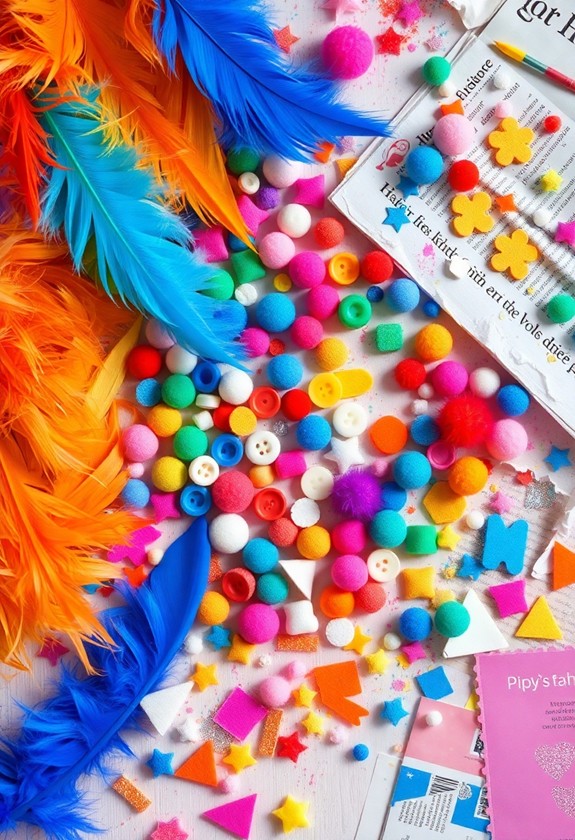
Hands on deck for a textured collage adventure! This project's a tactile treat that'll have your little one's fingers investigating a world of sensations. Gather an array of materials with different textures:
- Soft: cotton balls, feathers
- Rough: sandpaper, burlap
- Smooth: fabric swatches, ribbons
- Bumpy: bubble wrap, pom-poms
Now, let's get sticking! Spread some child-safe glue on a sturdy piece of cardboard or canvas. It's time for your toddler to go texture-hunting! Encourage them to pick up and feel each item before pressing it onto the glue. As they create, chat about the textures: "Ooh, that's scratchy!" or "Wow, so fluffy!" This multi-sensory experience aids in memory retention and information processing, essential for early childhood development. Regular crafting stimulates brain regions associated with problem-solving, creativity, and motor skills.
This sensory smorgasbord isn't just fun—it's fantastic for developing fine motor skills and vocabulary. Plus, you'll end up with a touchy-feely masterpiece!
Scented Play Dough Creation
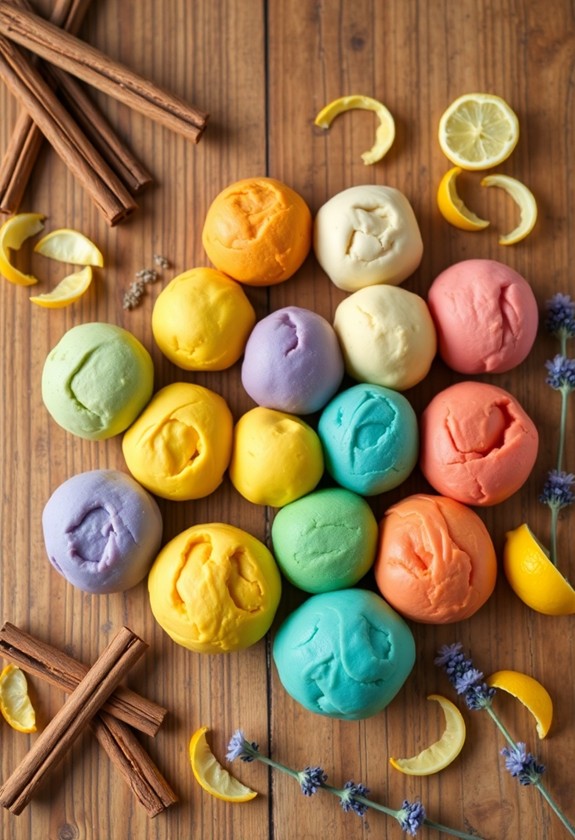
Let's move from textures to scents with our next sensory adventure! Get ready to whip up some aromatic play dough that'll tickle your tot's nose and spark their imagination. This hands-on activity is a real treat for the senses!
Here's what you'll need:
- Flour, salt, and water
- Food coloring
- Vital oils or extracts (like vanilla, lavender, or peppermint)
Mix the ingredients together, kneading until you've got a smooth dough. Now comes the fun part – add a few drops of your chosen scent and watch your little one's eyes light up! They'll love squishing, rolling, and shaping their fragrant creation. And here's a scent-sational idea: make multiple batches with different aromas for a smell-tastic playtime extravaganza! This nose-worthy activity is certain to be a hit!
Edible Finger Painting Fun
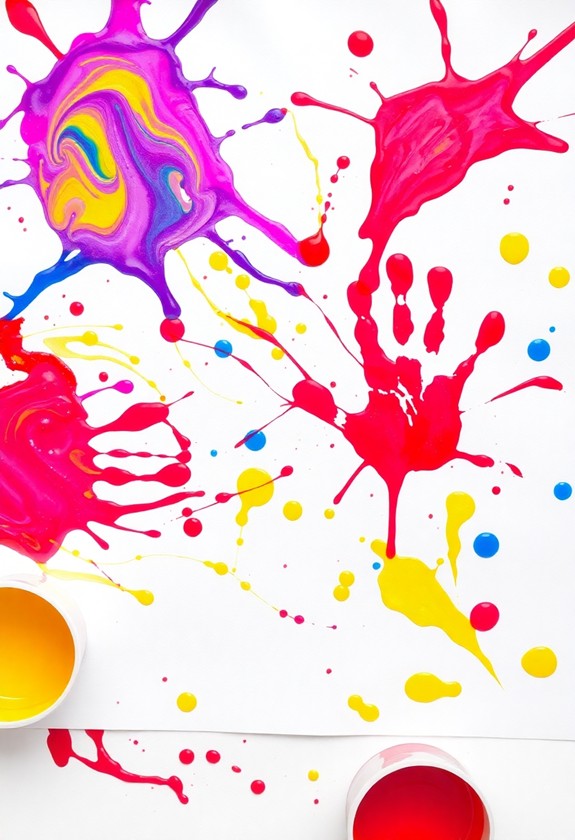
Considering our scented play dough adventure, it's time to explore another sensory delight: edible finger painting. This messy, tasty activity will have your little one squealing with joy! Although this isn't a mess-free option, it offers a unique sensory experience that promotes creativity and fine motor skills. Here's how to whip up some colorful, edible paint:
- Mix equal parts cornstarch and water
- Add a few drops of food coloring
- Stir until smooth
Now, let the fun begin! Spread out a large sheet of paper and let your toddler go wild. They'll love squishing the paint between their fingers and creating lively masterpieces. And don't worry if they sneak a taste – it's all safe to eat!
Pro tip: Use different fruits or veggies to make natural colors. Beet juice for pink, spinach for green – the possibilities are endless! Get ready for a finger-licking good time with this "paletteable" activity!
Sensory Rice Bin Art
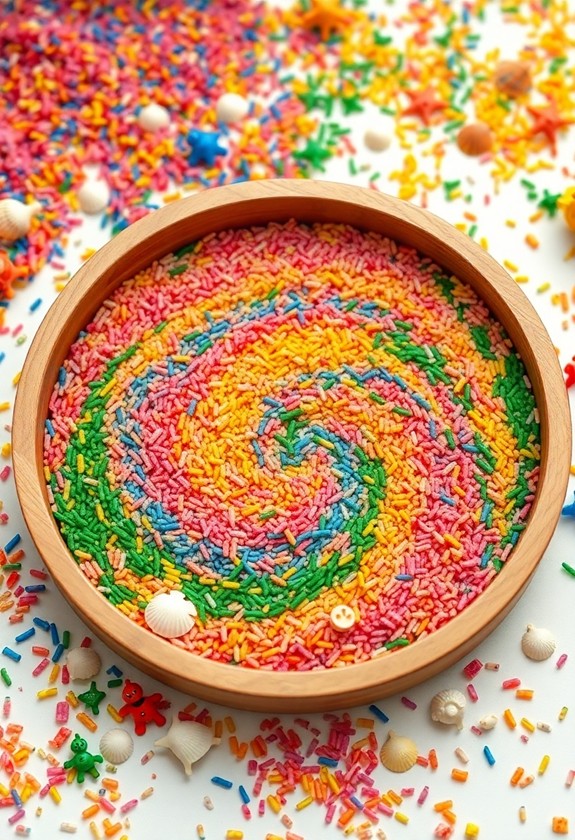
After investigating edible art, it's time to shift gears to a less messy but likewise engaging sensory experience. Sensory rice bin art is a fantastic way to stimulate your toddler's senses as you encourage creativity! Here's how to set it up:
- Fill a large, shallow container with uncooked rice
- Add colorful objects like buttons, beads, or small toys
- Include tools like scoops, funnels, and cups
Let your little one plunge in and investigate! They'll love the cool, grainy texture between their fingers. For added safety and easy cleanup, consider using washable markers to color the rice instead of food coloring. This method aligns with the growing trend of non-toxic, washable art supplies for children. Encourage them to create patterns, bury treasures, or practice pouring. It's a tactile wonderland!
But wait, there's more! You can easily jazz up your rice bin by dyeing the grains with food coloring. Imagine the rainbow possibilities! This activity isn't just fun – it's likewise great for developing fine motor skills and hand-eye coordination. So, get ready for some rice-tastic adventures!
Rainbow Spaghetti Sensory Play
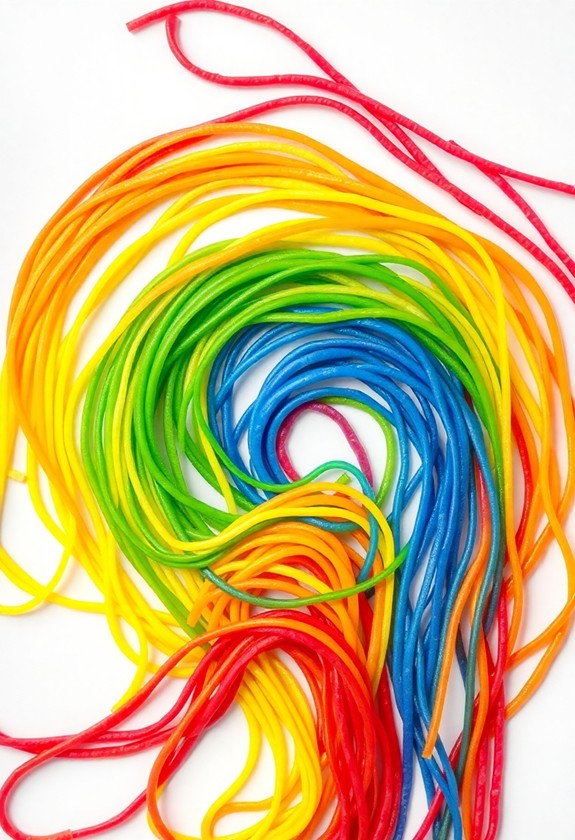
From edible art to rice play, we now venture into the colorful world of rainbow spaghetti sensory play. Get ready for a squishy, lively adventure that'll tickle your toddler's senses!
Here's how to create this pasta-tively amazing experience:
- Cook spaghetti until it's al dente
- Divide it into separate bowls
- Add food coloring to each bowl
- Mix well until the pasta is fully colored
This activity not only encourages creative fun but also helps develop fine motor skills as toddlers manipulate the colorful strands. Using water-based food coloring guarantees easy cleanup and reduces stain concerns.
Now, let your little one plunge into the fun! They'll love squishing, squeezing, and twirling the noodles. It's a tactile treat that's certain to delight!
Pro tip: Place a plastic tablecloth under the play area for easy cleanup. And don't worry if your tot tries to taste – it's all edible!
This activity isn't just fun, it's also great for developing fine motor skills and color recognition. So, get ready to noodle around with this sensational sensory play!
Bubble Wrap Printing Experience
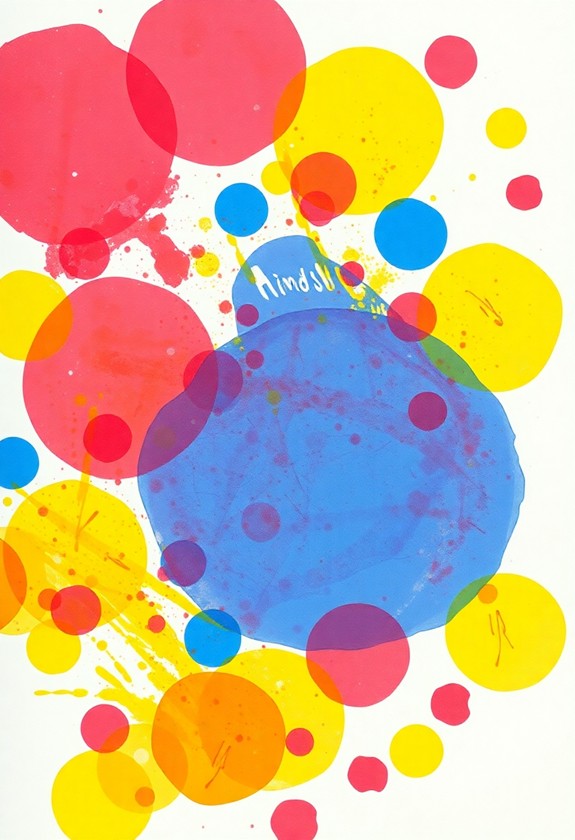
Let's plunge into the world of bubble wrap printing! This fun, tactile activity will have your little one giggling with glee during creating beautiful art. You'll need:
- Bubble wrap
- Paint
- Paper
Start by cutting bubble wrap into manageable sizes. Then, squirt some paint onto a plate and let your toddler dip the bubble wrap in. Watch their eyes light up as they press the paint-covered bubbles onto paper! The resulting patterns are certain to amaze.
But wait, there's more! Try these exciting variations:
- Mix colors for a rainbow effect
- Use different bubble sizes for varied textures
- Experiment with fabric instead of paper
This activity isn't just fun – it's a sensory explosion! Your child will love the squish of paint, the pop of bubbles, and the pride of creating their very own masterpiece. Get ready for a bubble-tastic adventure!
Curious Little Questions
How Can I Adapt These Projects for Children With Sensory Sensitivities?
Adapting projects for kids with sensory sensitivities is totally doable! Here's how:
- Start small: Introduce materials gradually
- Offer choices: Let them pick textures they're comfortable with
- Use calming tools: Provide noise-canceling headphones or sunglasses
- Create safe spaces: Set up a quiet corner for breaks
- Go slow: Allow extra time for exploration
- Be flexible: It's okay to modify or skip parts they don't enjoy
What Age Range Are These Activities Most Suitable For?
You're barking up the right tree with these activities! They're perfect for curious little ones aged 1 to 4. But don't let that stop you from trying them with older kids too! Here's a quick breakdown:
- 1-2 years: Simple, supervised exploration
- 2-3 years: More independent play, with guidance
- 3-4 years: Creative freedom, complex projects
How Do I Clean up After Messy Sensory Art Projects?
Cleaning up after messy art projects can be a breeze! Here's how you can tackle the aftermath:
- Start with a quick sweep or vacuum to catch loose bits.
- Wipe surfaces with warm, soapy water – it's a miracle worker!
- For stubborn stains, try a mix of baking soda and water. It's like magic!
- Don't forget to wash hands and tools thoroughly.
- Make cleanup fun by turning it into a game. Ready, set, clean!
Are There Any Potential Allergies to Consider With These Materials?
Allergies? Oh yes! You've got to be careful and considerate. Common culprits include:
- Wheat (in playdough)
- Dairy (in some paints)
- Nuts (in natural materials)
- Latex (in balloons or gloves)
But don't worry! You can still have fun. Just ask parents about allergies beforehand. There are plenty of alternatives:
- Rice flour playdough
- Nut-free sensory bins
- Latex-free options
Stay safe and get creative! With a little planning, you'll find allergy-friendly materials that are just as exciting and fun!
How Can I Extend These Activities to Promote Language Development?
You can accelerate language development with these fun activities. Here's how:
- Describe colors, textures, and actions as you go
- Ask open-ended questions about what they're creating
- Encourage them to name objects and materials
- Sing songs or recite rhymes related to the activity
- Create stories about their artwork together
Don't forget to praise their efforts and use new vocabulary words. It's amazing how quickly they'll pick up language when they're having a blast with art!

